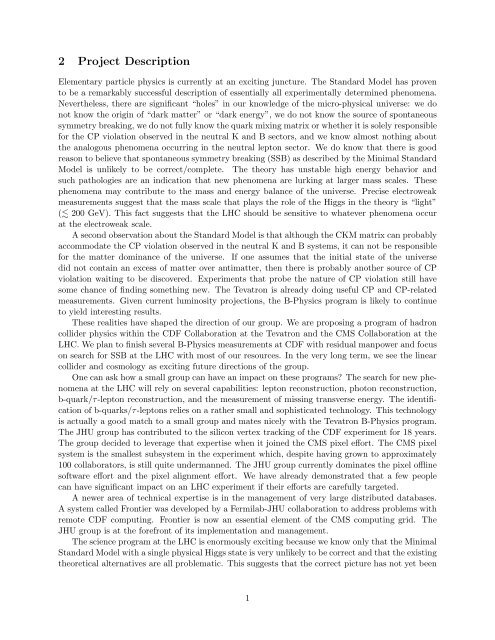proposal2007_draft09.. - Henry A. Rowland Department of Physics ...
proposal2007_draft09.. - Henry A. Rowland Department of Physics ...
proposal2007_draft09.. - Henry A. Rowland Department of Physics ...
Create successful ePaper yourself
Turn your PDF publications into a flip-book with our unique Google optimized e-Paper software.
2 Project Description<br />
Elementary particle physics is currently at an exciting juncture. The Standard Model has proven<br />
to be a remarkably successful description <strong>of</strong> essentially all experimentally determined phenomena.<br />
Nevertheless, there are significant “holes” in our knowledge <strong>of</strong> the micro-physical universe: we do<br />
not know the origin <strong>of</strong> “dark matter” or “dark energy”, we do not know the source <strong>of</strong> spontaneous<br />
symmetry breaking, we do not fully know the quark mixing matrix or whether it is solely responsible<br />
for the CP violation observed in the neutral K and B sectors, and we know almost nothing about<br />
the analogous phenomena occurring in the neutral lepton sector. We do know that there is good<br />
reason to believe that spontaneous symmetry breaking (SSB) as described by the Minimal Standard<br />
Model is unlikely to be correct/complete. The theory has unstable high energy behavior and<br />
such pathologies are an indication that new phenomena are lurking at larger mass scales. These<br />
phenomena may contribute to the mass and energy balance <strong>of</strong> the universe. Precise electroweak<br />
measurements suggest that the mass scale that plays the role <strong>of</strong> the Higgs in the theory is “light”<br />
( 200 GeV). This fact suggests that the LHC should be sensitive to whatever phenomena occur<br />
at the electroweak scale.<br />
A second observation about the Standard Model is that although the CKM matrix can probably<br />
accommodate the CP violation observed in the neutral K and B systems, it can not be responsible<br />
for the matter dominance <strong>of</strong> the universe. If one assumes that the initial state <strong>of</strong> the universe<br />
did not contain an excess <strong>of</strong> matter over antimatter, then there is probably another source <strong>of</strong> CP<br />
violation waiting to be discovered. Experiments that probe the nature <strong>of</strong> CP violation still have<br />
some chance <strong>of</strong> finding something new. The Tevatron is already doing useful CP and CP-related<br />
measurements. Given current luminosity projections, the B-<strong>Physics</strong> program is likely to continue<br />
to yield interesting results.<br />
These realities have shaped the direction <strong>of</strong> our group. We are proposing a program <strong>of</strong> hadron<br />
collider physics within the CDF Collaboration at the Tevatron and the CMS Collaboration at the<br />
LHC. We plan to finish several B-<strong>Physics</strong> measurements at CDF with residual manpower and focus<br />
on search for SSB at the LHC with most <strong>of</strong> our resources. In the very long term, we see the linear<br />
collider and cosmology as exciting future directions <strong>of</strong> the group.<br />
One can ask how a small group can have an impact on these programs? The search for new phenomena<br />
at the LHC will rely on several capabilities: lepton reconstruction, photon reconstruction,<br />
b-quark/τ-lepton reconstruction, and the measurement <strong>of</strong> missing transverse energy. The identification<br />
<strong>of</strong> b-quarks/τ-leptons relies on a rather small and sophisticated technology. This technology<br />
is actually a good match to a small group and mates nicely with the Tevatron B-<strong>Physics</strong> program.<br />
The JHU group has contributed to the silicon vertex tracking <strong>of</strong> the CDF experiment for 18 years.<br />
The group decided to leverage that expertise when it joined the CMS pixel effort. The CMS pixel<br />
system is the smallest subsystem in the experiment which, despite having grown to approximately<br />
100 collaborators, is still quite undermanned. The JHU group currently dominates the pixel <strong>of</strong>fline<br />
s<strong>of</strong>tware effort and the pixel alignment effort. We have already demonstrated that a few people<br />
can have significant impact on an LHC experiment if their efforts are carefully targeted.<br />
A newer area <strong>of</strong> technical expertise is in the management <strong>of</strong> very large distributed databases.<br />
A system called Frontier was developed by a Fermilab-JHU collaboration to address problems with<br />
remote CDF computing. Frontier is now an essential element <strong>of</strong> the CMS computing grid. The<br />
JHU group is at the forefront <strong>of</strong> its implementation and management.<br />
The science program at the LHC is enormously exciting because we know only that the Minimal<br />
Standard Model with a single physical Higgs state is very unlikely to be correct and that the existing<br />
theoretical alternatives are all problematic. This suggests that the correct picture has not yet been<br />
1
















